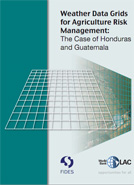Weather Data Grids for Agriculture Risk Management: The Case of Honduras and Guatemala

One of the major constraints for the improvement of agricultural risk management in Central America, and in particular to the development of weather index-based insurance, is the availability of complete meteorological data. Limitations with the data are related to restrictions in weather station coverage (density), and problems with the quality (errors and gaps in the information) and availability of historical records. This paper evaluates the reconstruction of historical meteorological records with gridded datasets for Honduras and Guatemala using the methodology in Uribe Alcantara et al. (2009). The reconstruction with synthetic series is implemented by replacing missing observations with estimations from regular grids (or gridded analyses). The development of synthetic series proposed here will facilitate, among other potential uses, the implementation of risk analysis in insurance contracts where meteorological information is limited or incomplete.
There are several additional applications of the gridded analysis that can be beneficial for the development of weather insurance. For example, gridded datasets can be used for the estimation of climatologies and hazard maps. They can also be combined with models such as crop productivity, atmospheric or hydraulic models and provide more specific products such as risk maps for drought, excess rain or flood risks. Furthermore, the availability of complete historical records together with more accurate risk assessments will not only facilitate the development of index-based insurance, but can also improve the risk assessments of traditional insurance contracts.